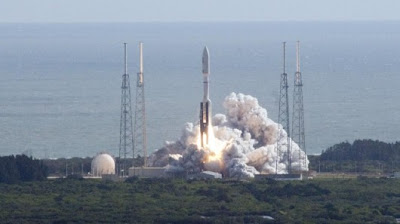Military
technology has created some fearsome weapons, such as the 5,000 lb GBU-28 Deep
Throat bunker buster, 15,000 lb BLU-82 Daisycutter, 15,650 lb Russian ATBIP
(Aviation Thermobaric Bomb of Increased Power), 22,000 lb Grand Slam earthquake
bomb, and the 22,600 lb GBU-43 MOAB (Massive Ordnance Air Blast), but if you
were hiding under 50 meters of hardened concrete, none of them were going to
bother you.
Not anymore! The
U.S. Air Force has just taken delivery of the first GBU-57A/B (Massive Ordnance
Penetrator). It weighs 30,000 lb and will penetrate 200 ft of hardened concrete
BEFORE it goes off. If you are reading this from an underground nuclear
facility in Iran or North Korea, might we suggest some extended sick leave is
(or soon will be) in order.
 |
| Artist's impression of GBU-57A/B |
Perhaps the most
surprising aspect of the Massive Ordnance Penetrator is that it is a relatively
simple weapon. The GBU acronym at the front of the
official designation for the Massive Ordnance Penetrator (GBU-57A/B or MOP) can
be found at the front of the name of almost everything the United States Air
Force drops from a plane these days.
Not all that long
ago, bombs were dropped in large numbers in the hope that at least some of them
would hit their target. These days, almost every bomb and missile
is delivered with pinpoint accuracy. GBU stands for Guided Bomb Unit, and it
means that the 20 foot GBU-57 A/B missile is zeroed in on the target by a GPS
navigation system guiding its four lattice-type fins.
Not surprisingly,
the bomb is intended for only one purpose - to destroy the type of hardened
concrete bunkers which house central command facilities and weapons of mass
destruction. It's hence not surprising that the program has been hurried into
readiness with the growing concern that Iran has developed nuclear weaponry.
It is designed to
penetrate supposedly untouchable facilities in one piece. The warhead case of
the MOP is made from a special high performance steel alloy designed to
maintain the integrity of the penetrator case during impact so that the payload
can then do its job most effectively by exploding deep underground. The
GBU-57A/B will penetrate 200 ft (61 m) of 5,000 psi (34 MPa) reinforced
concrete, 26 ft of 10,000 psi (69 MPa) reinforced concrete or 130 ft (40 m) of
moderately hard rock
The MOP is
deployed from high altitude and allows gravity to add momentum to its 30,000
pound weight so that it hits with enormous kinetic energy. Put simply, the MOP
hits exactly where it is intended to hit with enough energy to bury itself 200+
feet into hardened concrete, then it explodes its 5,300 pound warhead.
The MOP is
designed to be carried aboard B-2 and B-52 bombers so there's nowhere that is
out of reach. The B-52 has a combat range of nearly 9000 miles, but aerial
refueling means it effectively has an unlimited range.
With aerial
refueling, there is now nowhere to hide.
All copyright © Gizmag 2003 - 2011 http://www.gizmag.com






